This easy Korean Japchae recipe is full of vegetables, lean protein, and features the most amazing sauce! Tasty glass noodles are cooked stir-fry style with tender chicken, fresh vegetables, eggs, and the perfect blend of seasonings for an easy dinner on busy weeknights. Once you try this classic Korean recipe, you’ll fall in love and want to make it every week for a healthy dinner!
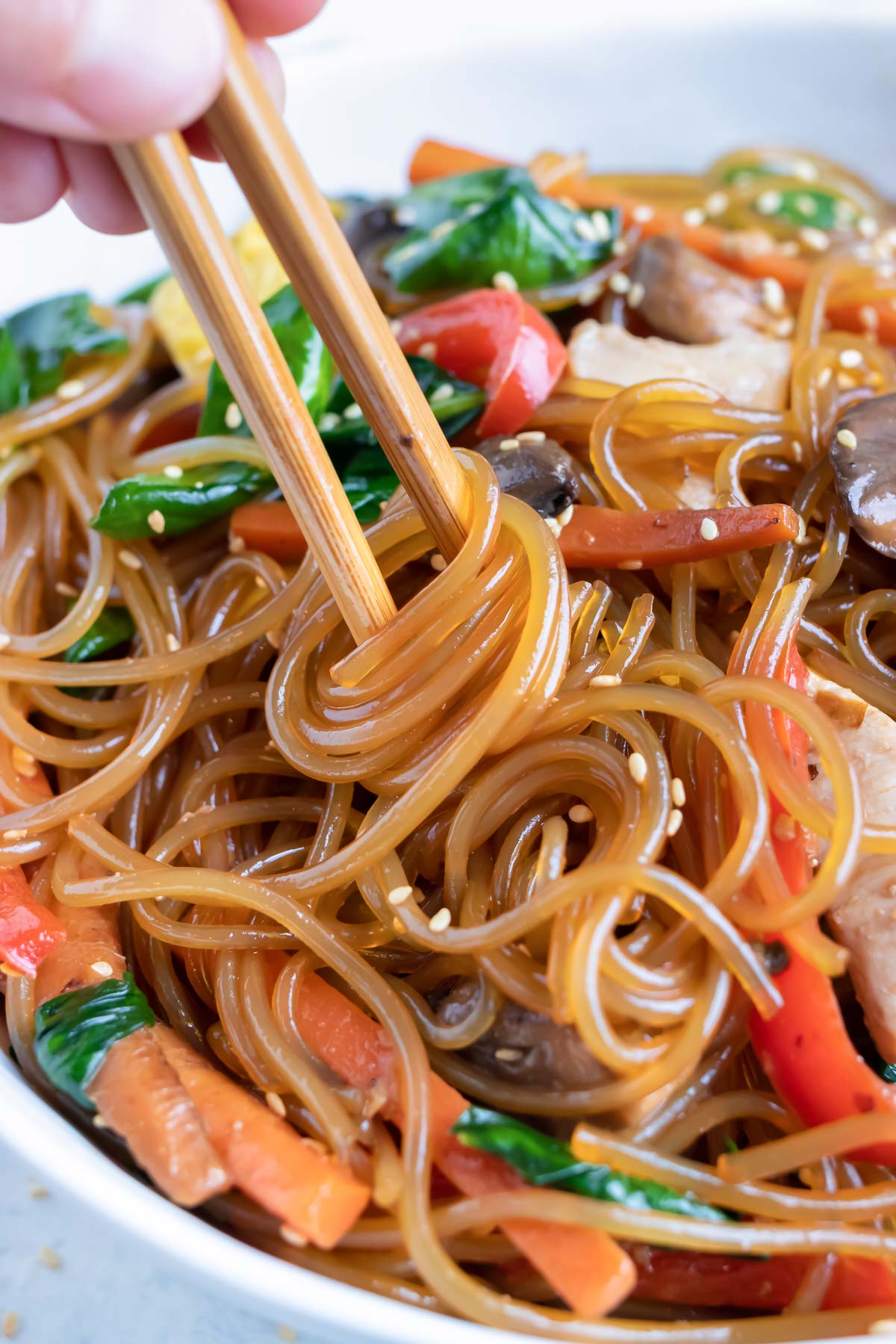
Korean food wasn’t even on my radar. I had sort of written it off falsely assuming it would be too spicy for my mild-only palate.
But on one of our weekly date nights, we decided to be adventurous and try out Oseyo, now responsible for my massive love of Korean cuisine!
Korean fried chicken, steamed dumplings, a big bowl of Dolsat Bibimbap with a side of kimchi, and then… Korean Japchae.
This dish reminded me of Sesame Noodles, but was loaded with so many other ingredients. Thin strips of eggs, tender chicken, and TONS of vegetables.
The glass noodles had a silky-smooth texture, a chewy bite, and were made out of sweet potatoes, of all things! My mind was COMPLETELY blown, and trying to make it for myself quickly became inevitable.
While there are a few ingredients that you’ll need to gather, it’s actually a pretty simple stir-fry recipe that you can easily throw together on a weeknight.
And the best part? If you have leftovers, the flavors seriously get better with time!
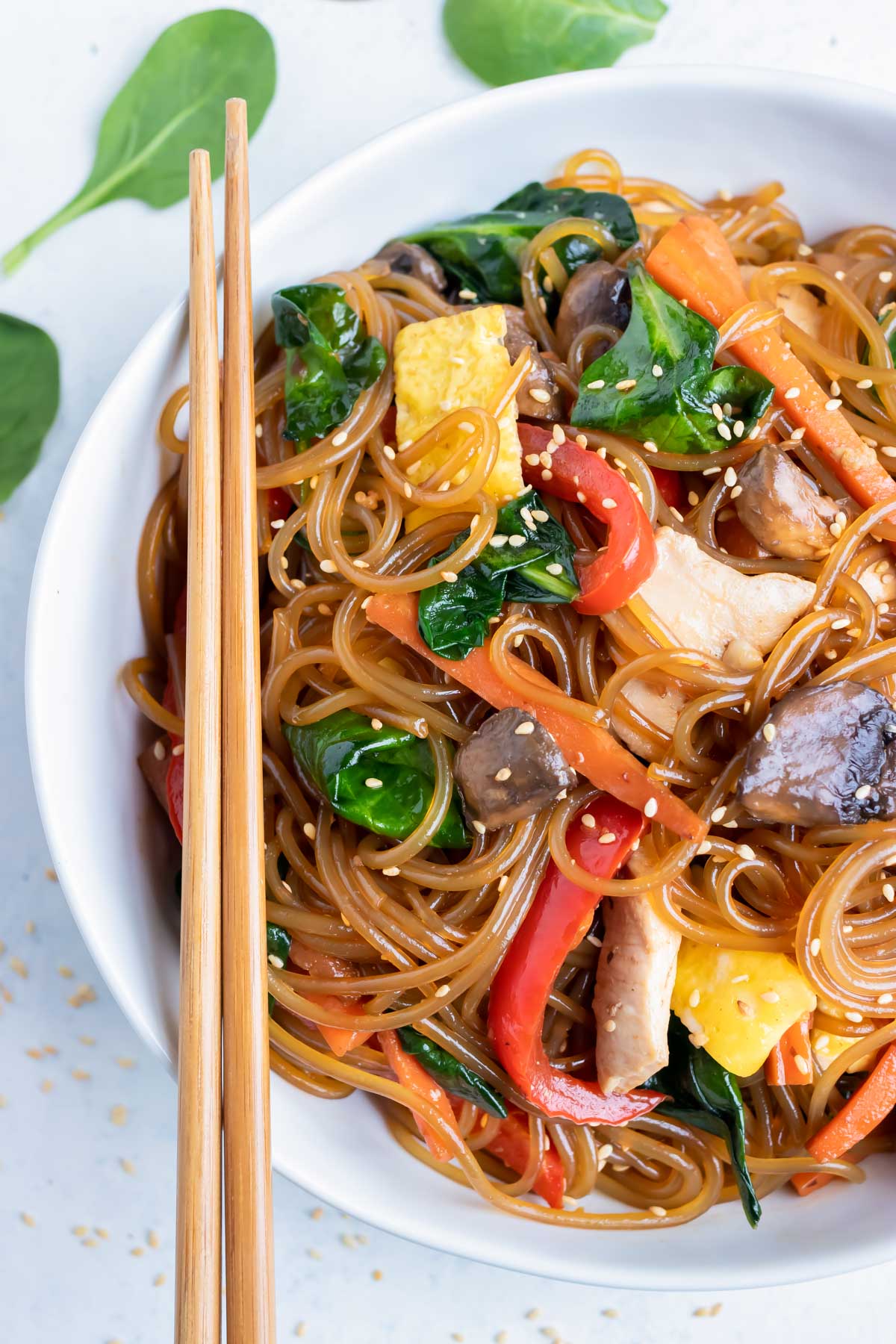
What is Japchae?
Incredible! But more than that, Japchae is a Korean dish made with glass or starch noodles, vegetables, and often meat and egg.
The name literally translates to “mixed vegetable,” which makes sense as it’s a stir-fry dish!
Japchae’s flavor is savory but with a hint of sweet, and it can be enjoyed either hot or cold, which can only mean one thing: a bonus meal from leftovers!
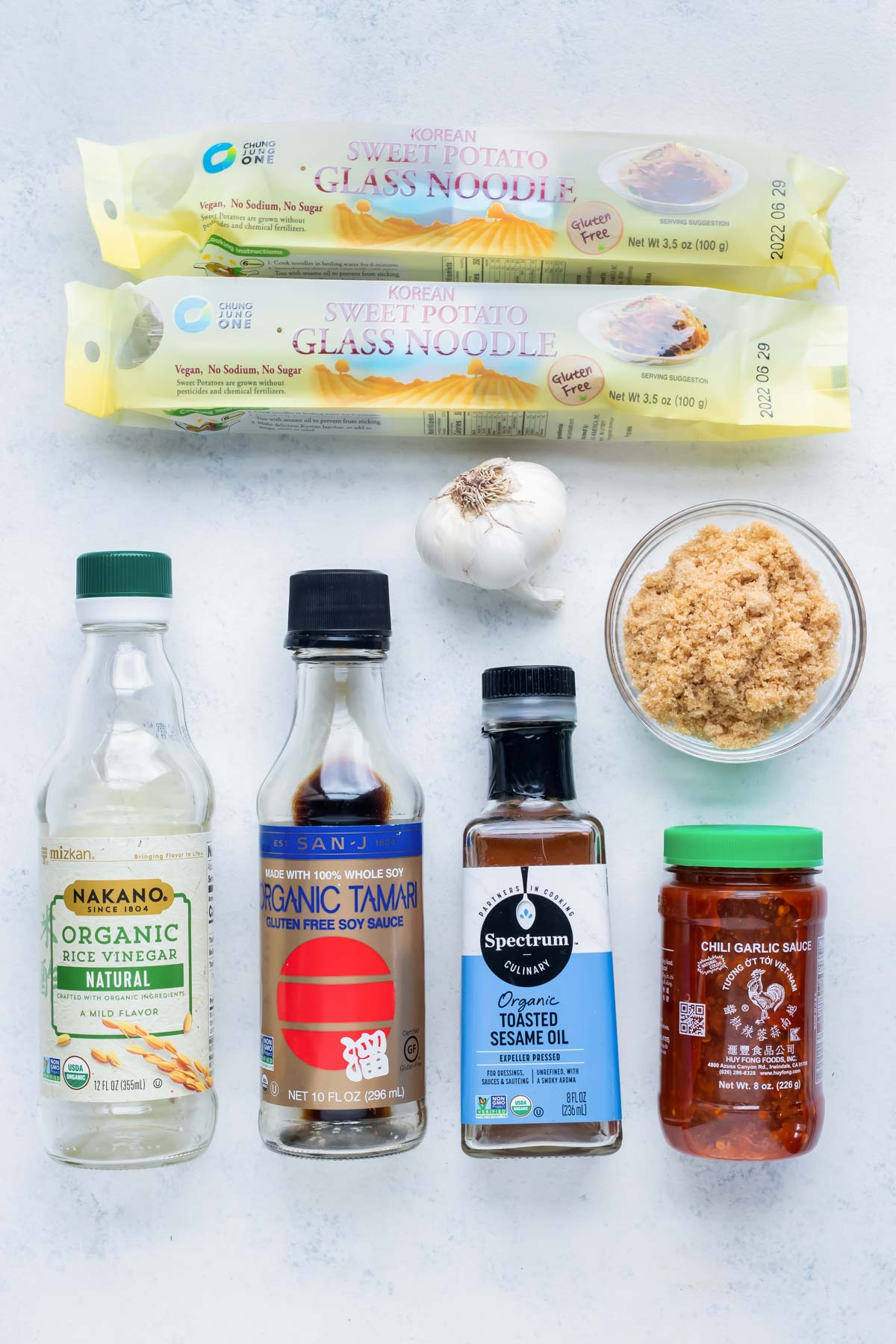
What are Glass Noodles?
The transparent noodles in this Japchae recipe are called glass noodles, also known as cellophane noodles or sweet potato starch noodles. No matter what you call them they’re delicious!
These particular noodles are the Korean variety dangmyeon. They’re made from sweet potato starch and water, and are a little thicker than the Chinese varieties you may have had before.
Glass noodles are often used in stir-fries, but are also sometimes featured in soups or hot pots.
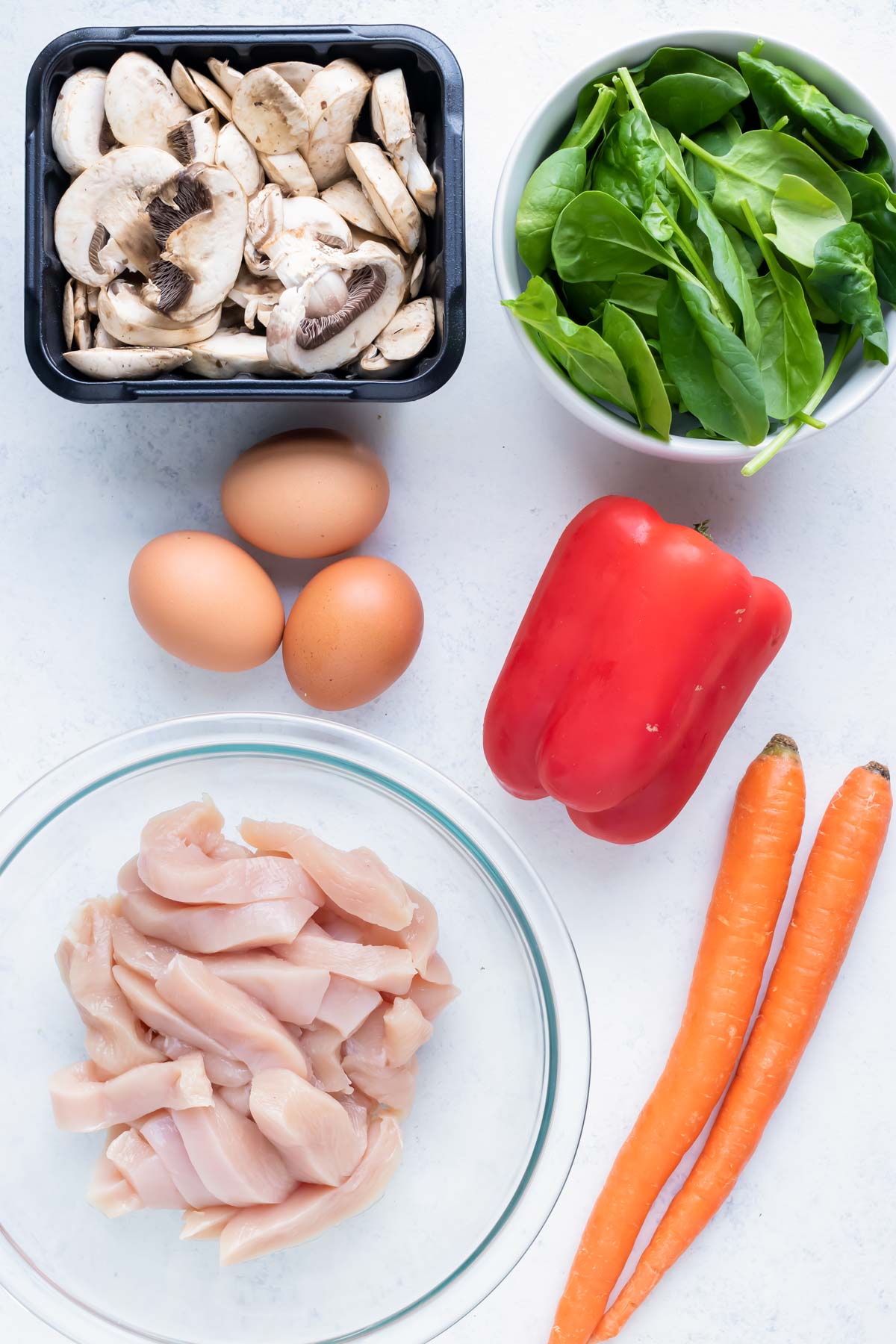
Ingredients
To make this easy Korean Japchae recipe you need:
- Glass Noodles. To make the traditional Korean recipe you should use dangmyeon, but it’s not necessary. In fact, just use what’s easiest to find at your grocery store, which is normally glass noodles.
- Chicken. This recipe calls for chicken breasts, but you can also use thighs if you prefer.
- Vegetables. Carrots, bell peppers, mushrooms, spinach, and garlic are best. You can also use broccoli, bok choy, onions, or whatever else you happen to have on hand!
- Eggs. You’ll need three large eggs for this recipe. Generally organic, pasture-raised eggs are best, but any will do.
- Soy Sauce. Make sure to use a gluten-free soy sauce or tamari to keep this recipe gluten-free, if needed.
- Rice Vinegar. It is important to make sure you use rice vinegar and not seasoned rice vinegar, as it has added sugar. Any fan of Asian cooking should always have rice vinegar on hand, but if you happen to be out, apple cider vinegar or white wine vinegar is your best bet for a substitute.
- Oil. Both sesame oil and avocado oil are used in this recipe. The sesame oil really adds a ton of flavor, so make sure you don’t leave this out. The avocado oil can be swapped out with any other high smoke point oil like safflower, peanut, or canola oil. Just make sure it is a high-smoke point oil so it doesn’t burn.
- Brown Sugar. The slightly sweet flavor is achieved with adding in brown sugar. Coconut sugar may also be used.
- Sriracha. This adds a little sweet and spicy kick. You may also use another hot sauce without a sweetener if you are avoiding refined sugar.
- Toasted sesame seeds. These are entirely optional but add such a nice, nutty flavor and delicately crunchy texture.
Note: For more information on how to prepare garlic for this recipe, see How to Mince Garlic.
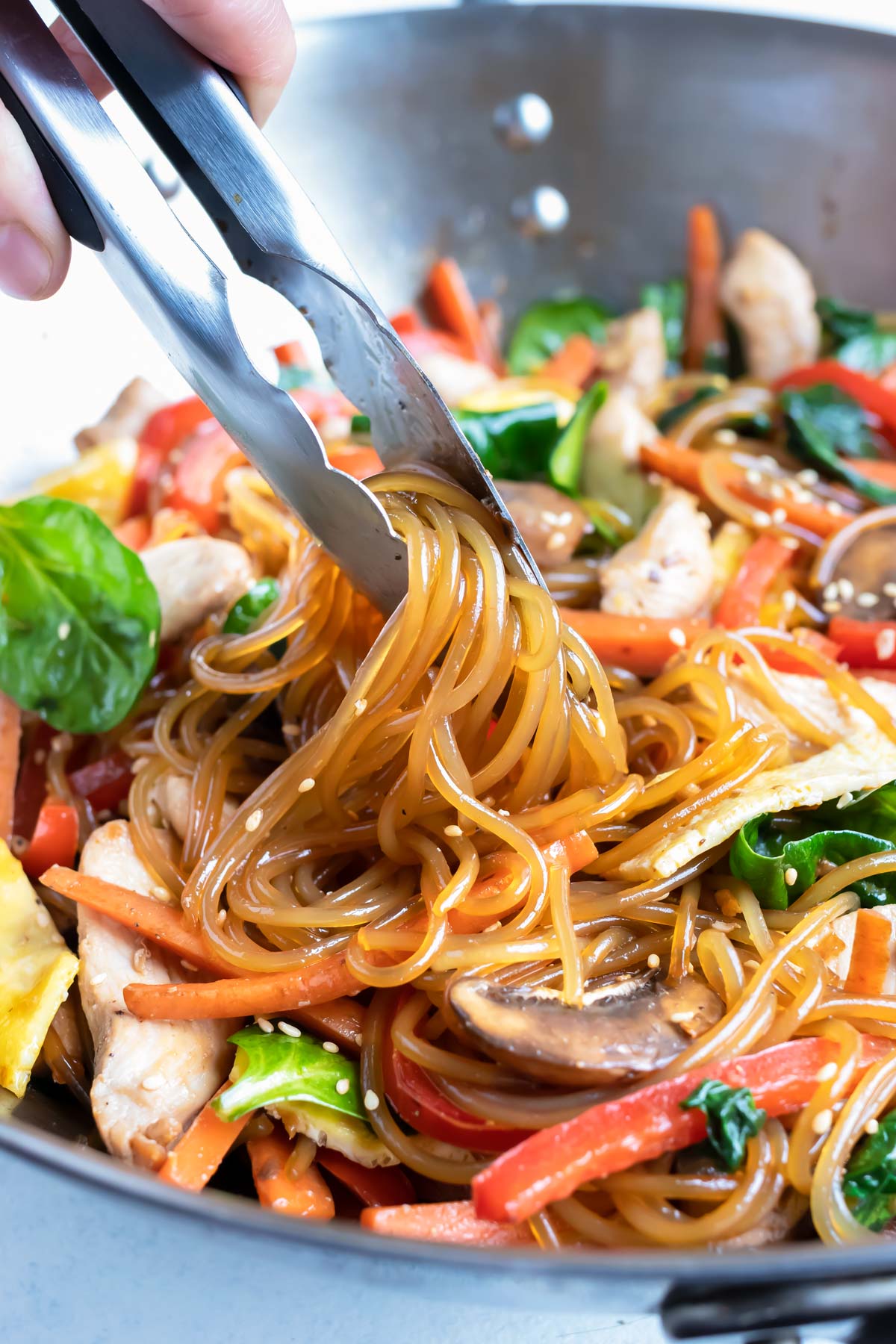
How to Make Japchae
These are the easy steps for making Korean Japchae:
Cook the Noodles
In a large pot, heat water up to a boil and cook the noodles for 6-8 minutes, or according to the instructions on the package. They should be tender, but not overcooked, and still with a little bit of a bite to them.
When finished boiling, test a noodle for the correct texture – soft, but just slightly chewy – then use a colander to drain the noodles. Be wary if using a colander with large holes, as some noodles may fall through.
Once drained, add the noodles back into the pot and set aside.
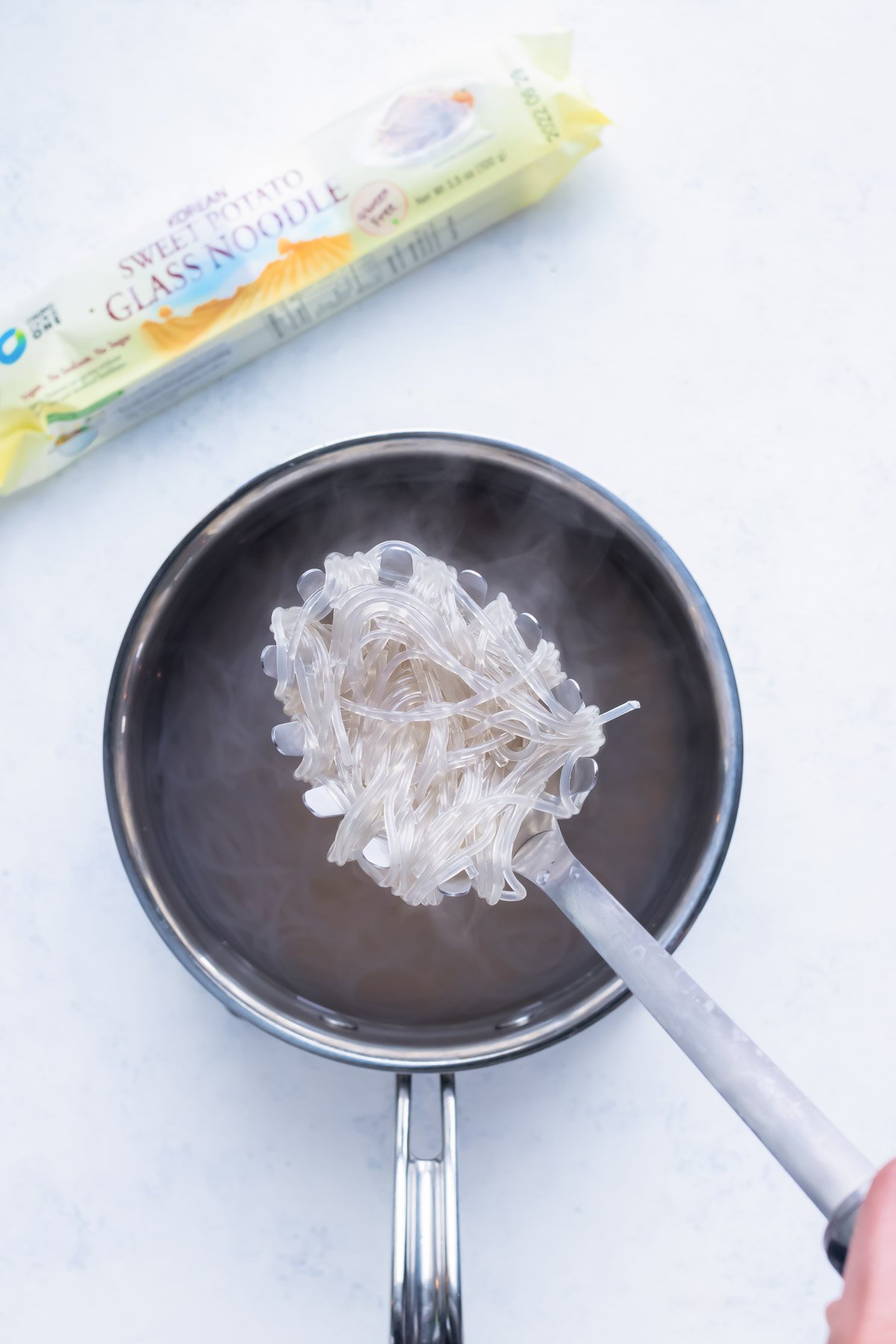
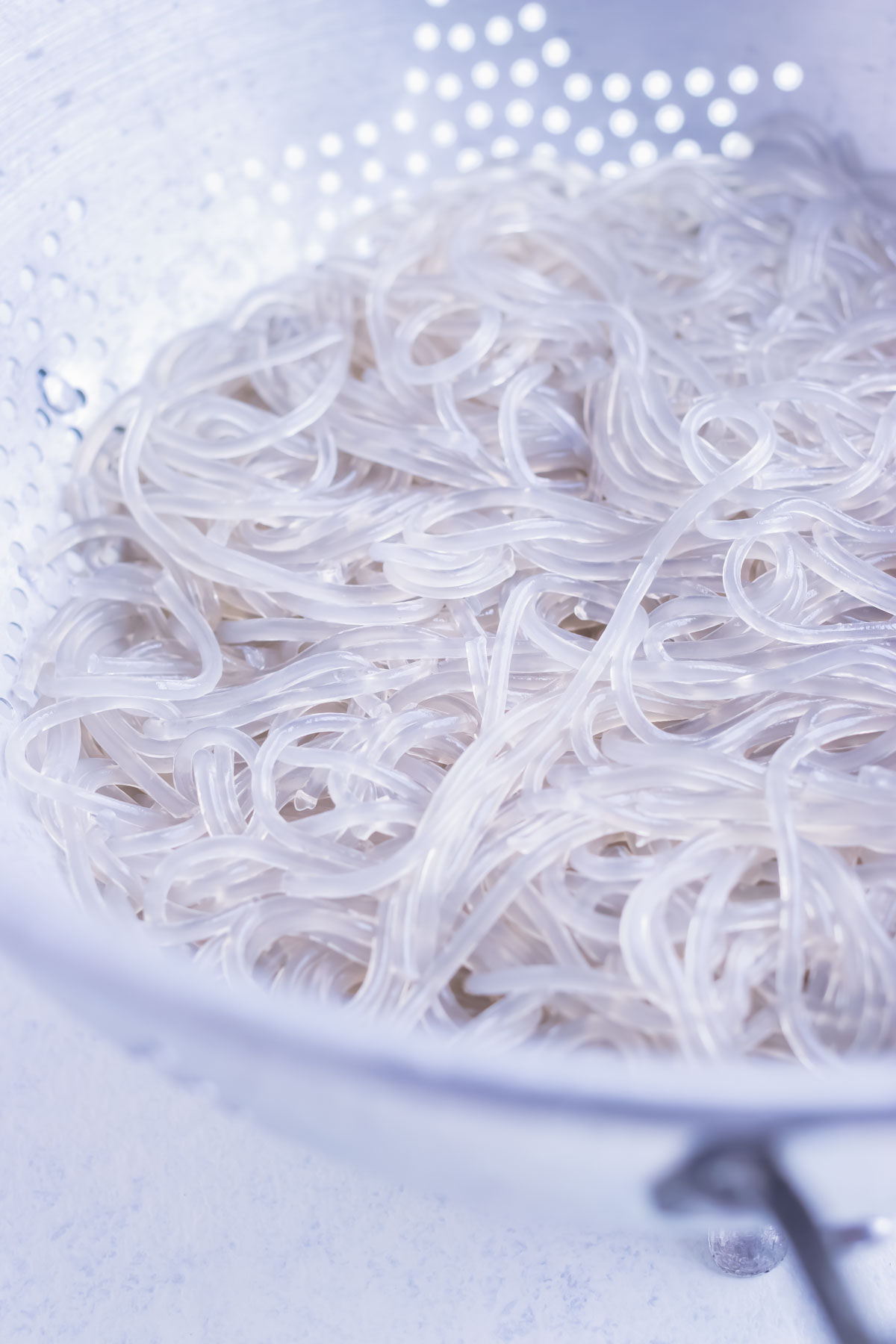
Add the Sauce
In a medium-size bowl, whisk together the soy sauce, rice vinegar, oil, brown sugar, and sriracha. This sauce can also be prepared ahead of time, if needed!
Pour the sauce into the pot with the cooked glass noodles, and stir to coat them fully. Be careful not to be too rough with them, as they can break apart.
Allow the noodles to sit in the sauce while preparing the rest of the recipe, so that the noodles can soak up all of that amazing flavor!
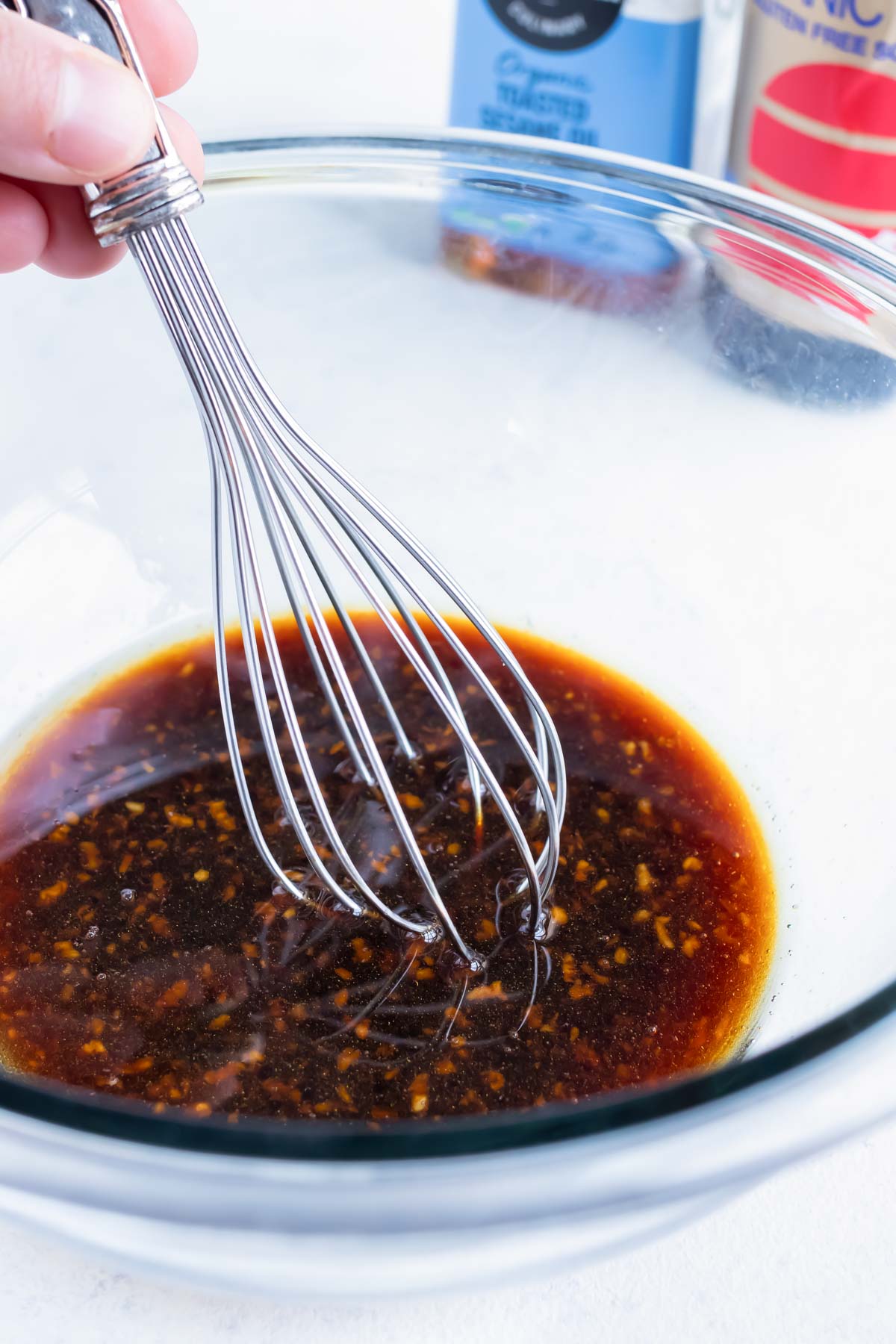
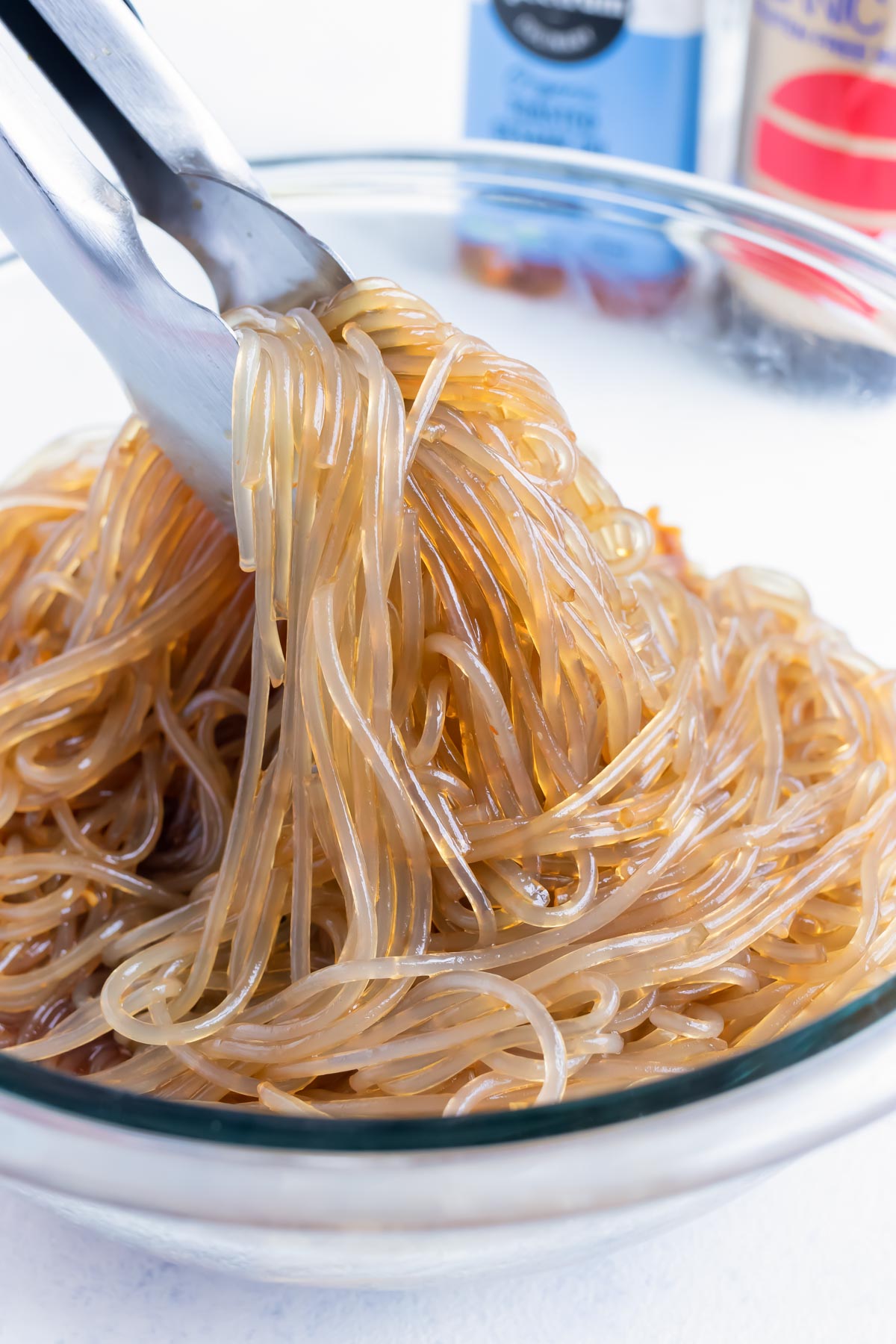
Prepare the Chicken
Lay out your raw chicken breasts on a cutting board, and use a very sharp knife to slice them into thin strips. Try to keep them a similar width, so that the chicken all cooks evenly.
In a large bowl, combine 1 tablespoon of soy sauce, the rice vinegar, and 1 clove of minced garlic. Add the raw chicken strips, and toss them to ensure the chicken is well coated in the marinade.
Set aside, and allow to marinate for 20 minutes while preparing the rest of the ingredients. The marinating process will tenderize the meat and allow it to soak up all of those amazing flavors!
Once finished marinating, stir-fry the chicken in 1 tablespoon of oil over medium-high heat for 3-4 minutes, or just until cooked through.
Keep a close eye on it and make sure you don’t overcook the chicken, otherwise it will turn out too tough.
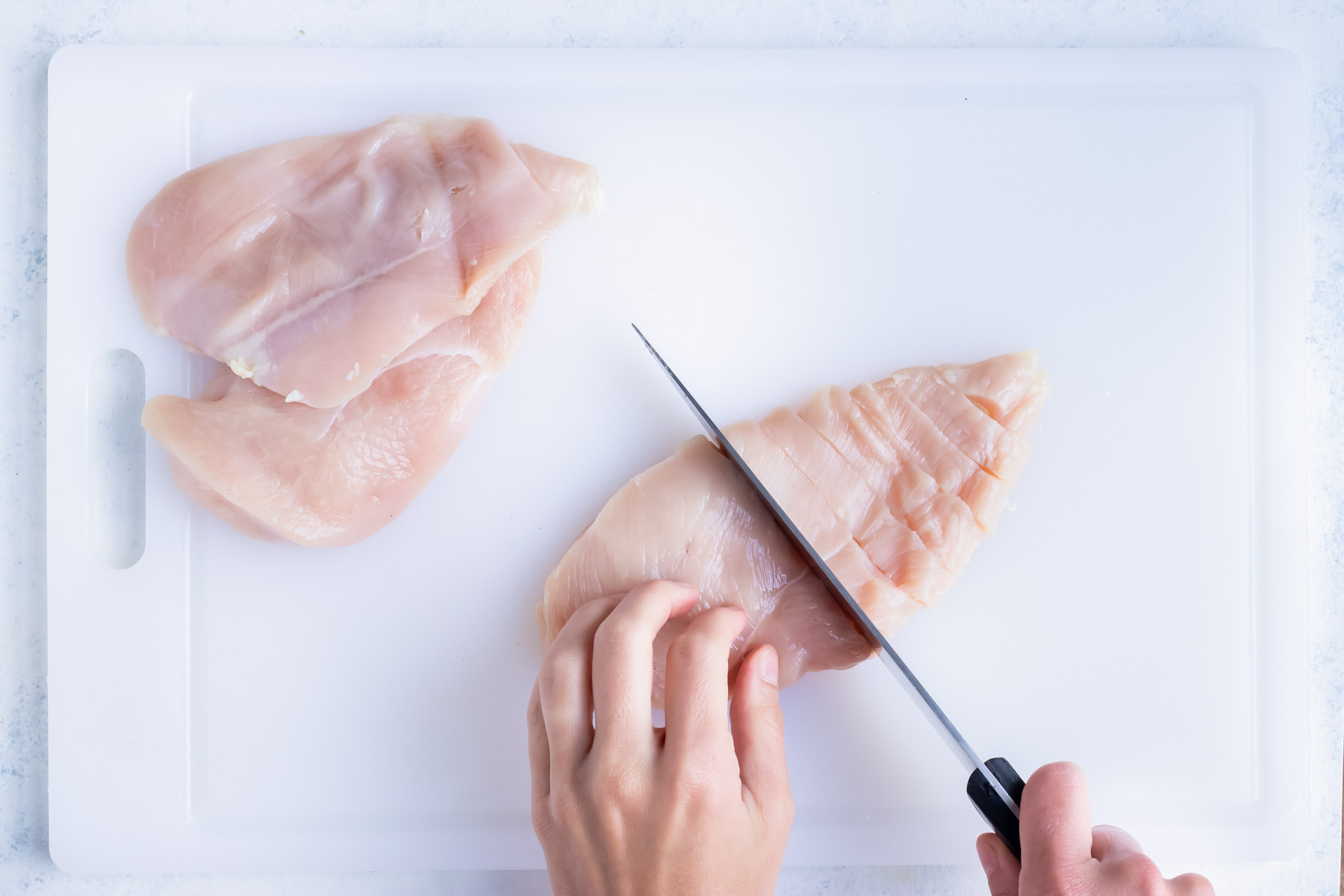
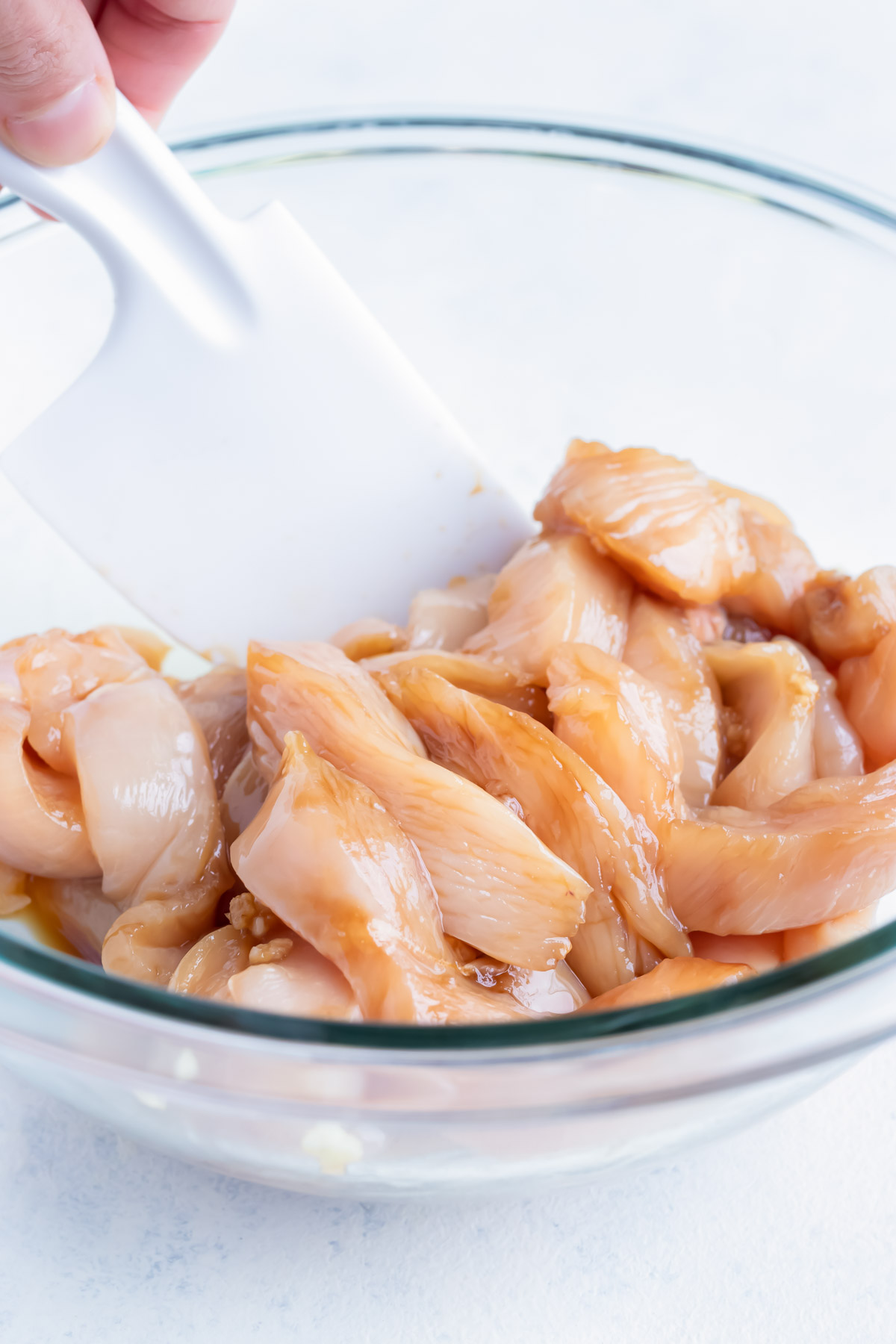
Cooking the Eggs
In a medium-sized bowl, whisk the eggs until they are evenly mixed and have turned light and fluffy.
Remove the chicken from the skillet and set it aside, then drizzle more oil into the pan, swiping it around to ensure even coverage.
Pour the eggs into a thin layer that completely coats the bottom of the pan. Do this by swirling the pan around until the eggs reach the edges. Kind of like when making a crepe!
Cook without stirring until done – this should take about 2-3 minutes. Carefully remove the eggs from the pan with a spatula, and cut them into long, thin strips.
Set the cooked, sliced egg aside as well.
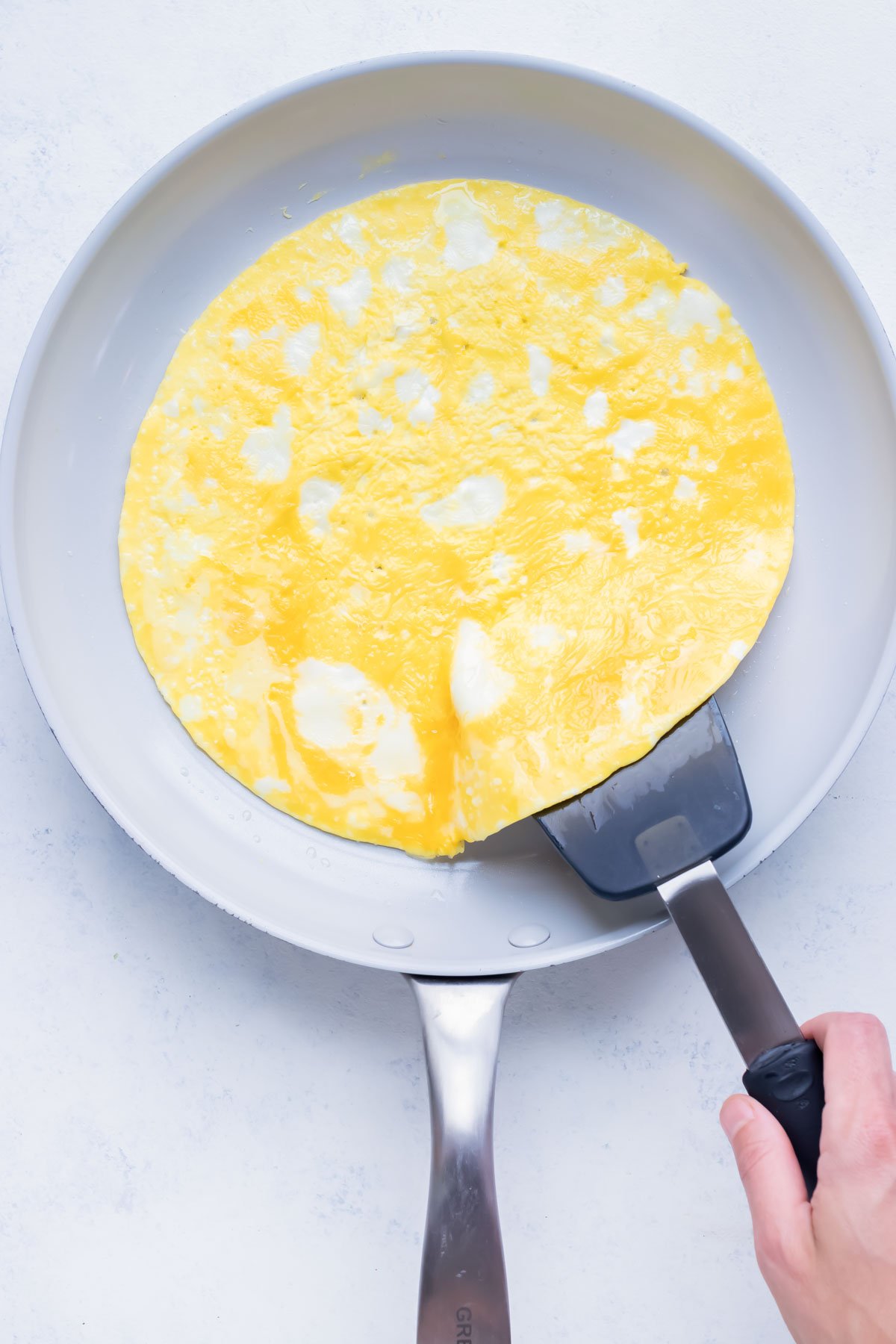
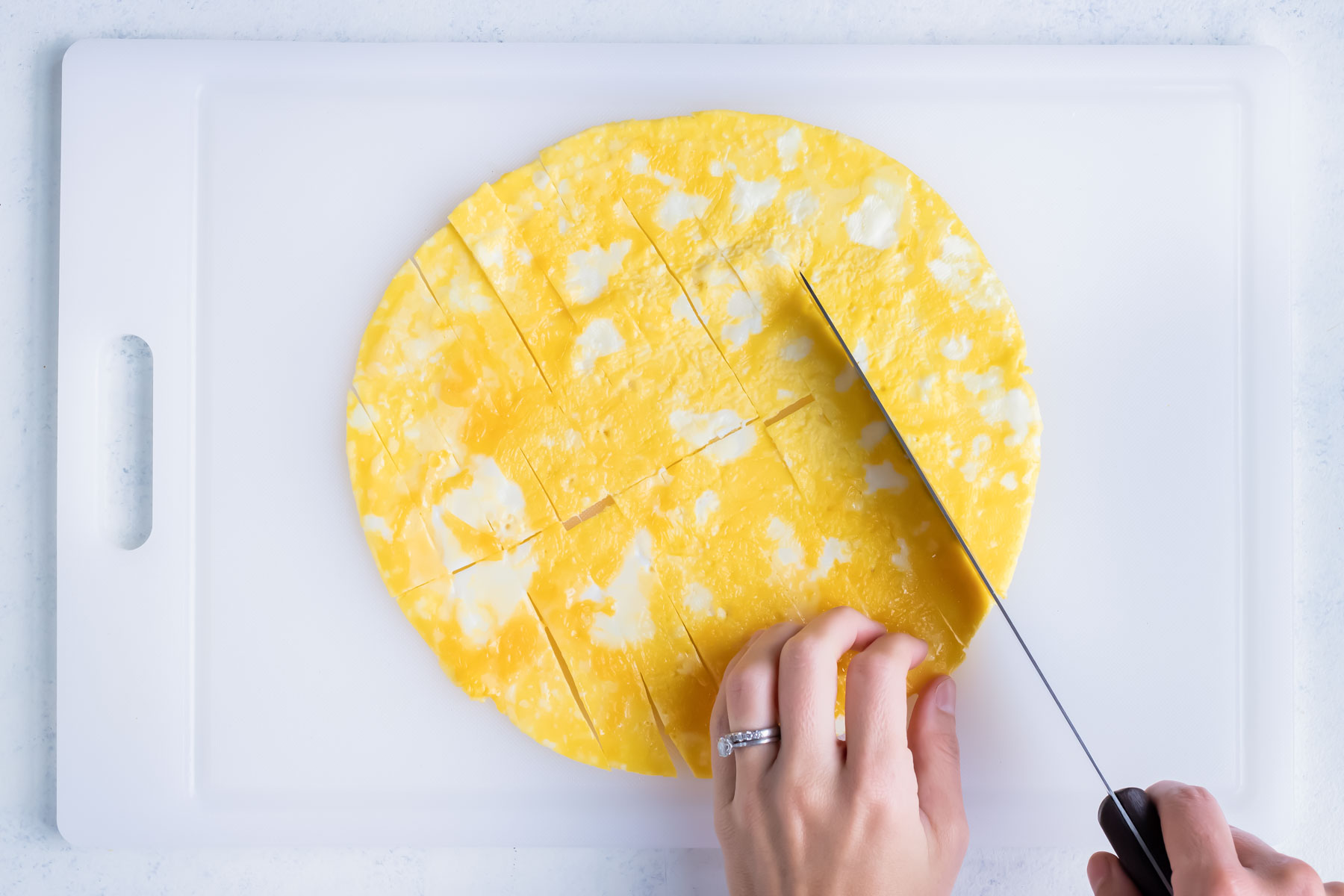
Make the Stir Fry
To the large skillet, add a bit more oil and allow it to come up to heat, so as to stir-fry your vegetables.
Start with the carrots, next add the bell pepper, then the mushrooms, and finally the spinach. The harder veggies take longer to cook, so you want to make sure to follow this order.
Add the chicken, noodles, and egg back into the pan. Cook until everything is heated through, and thoroughly coated in the sauce.
Serve the stir-fry immediately after cooking. Sprinkle with toasted sesame seeds, if desired, and dig in!
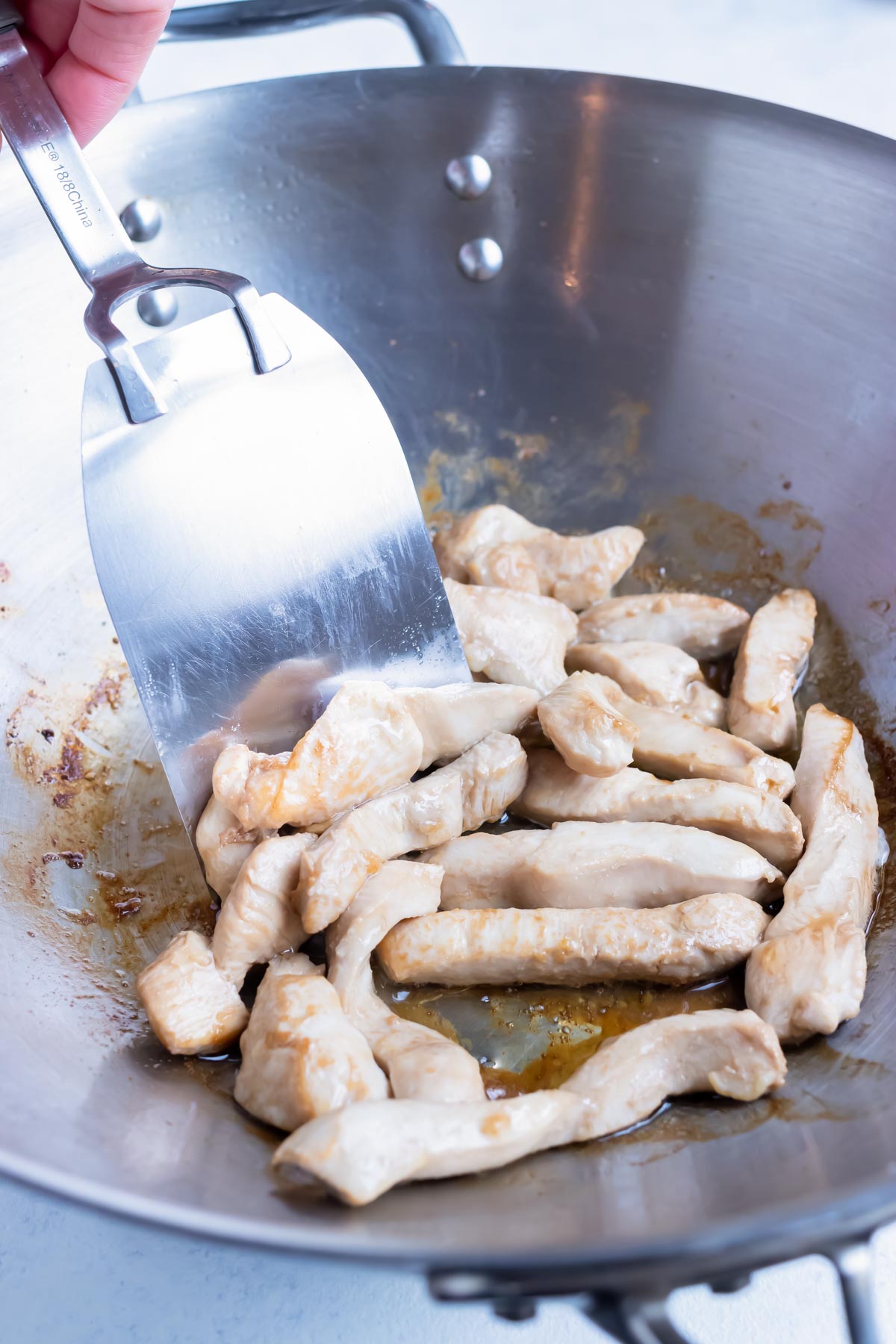
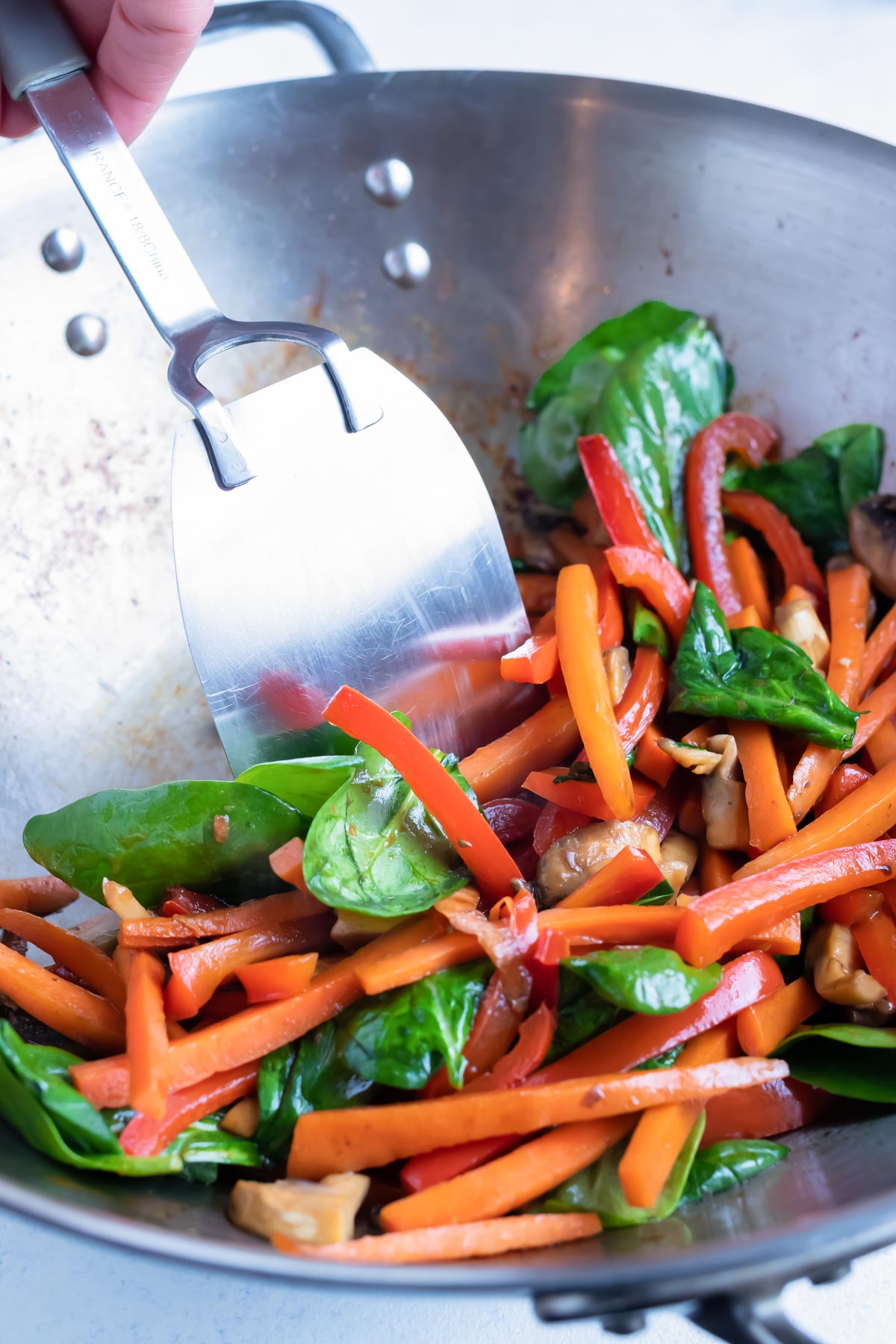
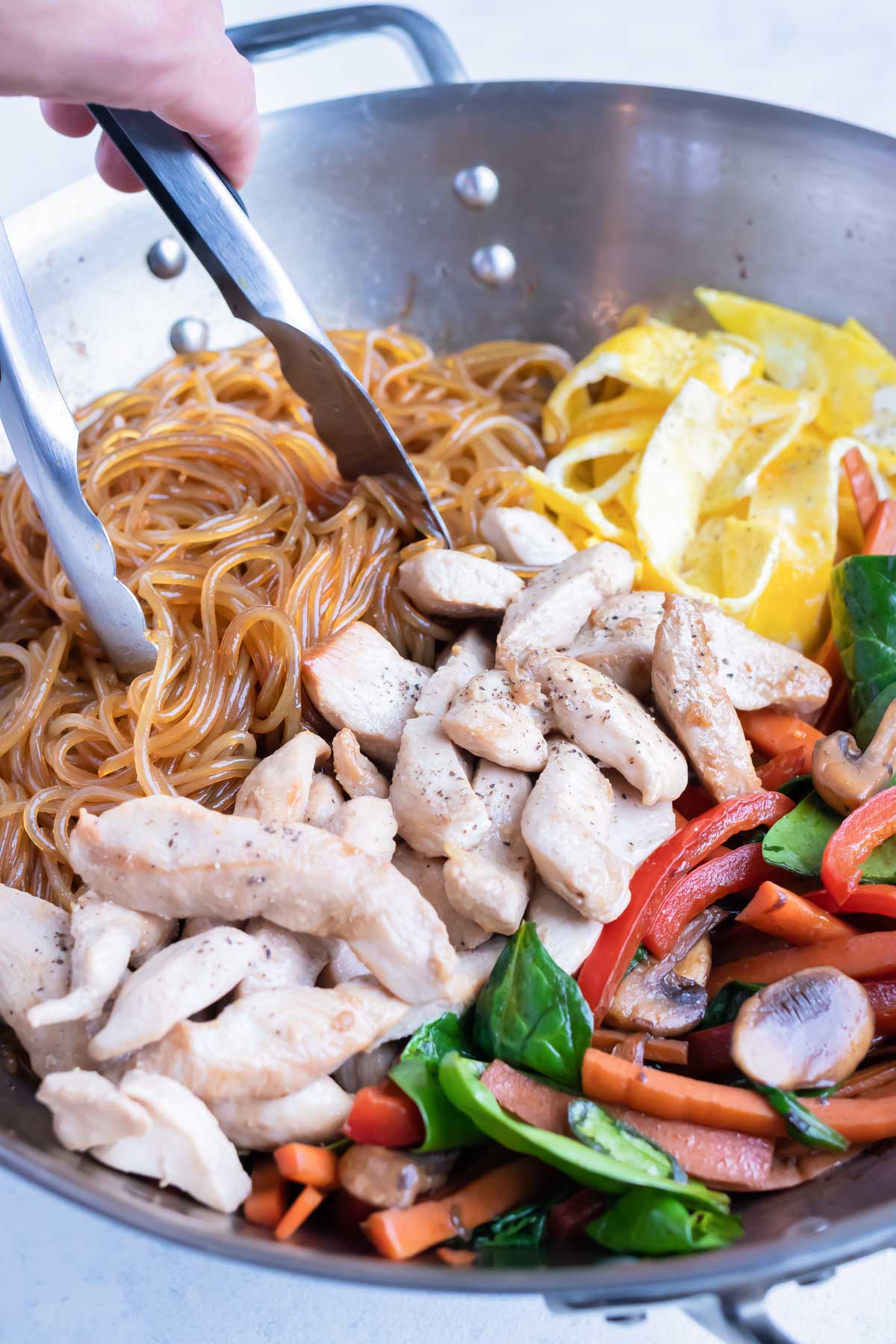
Meal Prep and Storage
- To Prep-Ahead: This entire recipe can be made ahead of time because the flavors only get better! But if you just want to do a little prep beforehand to make dinnertime easier, you can cut up the veggies and chicken up to 1 day in advance. If you take this route, wait to cook the noodles until just before serving.
- To Store: Keep any leftovers in an airtight container in the refrigerator for up to 3-4 days. Freezing is not recommended as the textures will will change once thawed.
- To Reheat: For the best results, reheat by adding back into a skillet on medium heat for 5-8 minutes. But remember, this dish is also great cold!
Dietary Modifications
The recipe you’ll find below is already dairy-free as written. Here are some adjustments and substitutions you can make to help it fit your other dietary requirements:
Gluten-Free: Use wheat-free soy sauce such as Tamari or coconut liquid aminos.
Soy-Free: Substitute the soy sauce with coconut liquid aminos.
Vegan: Omit the chicken and eggs.
Vegetarian: Leave out the chicken.
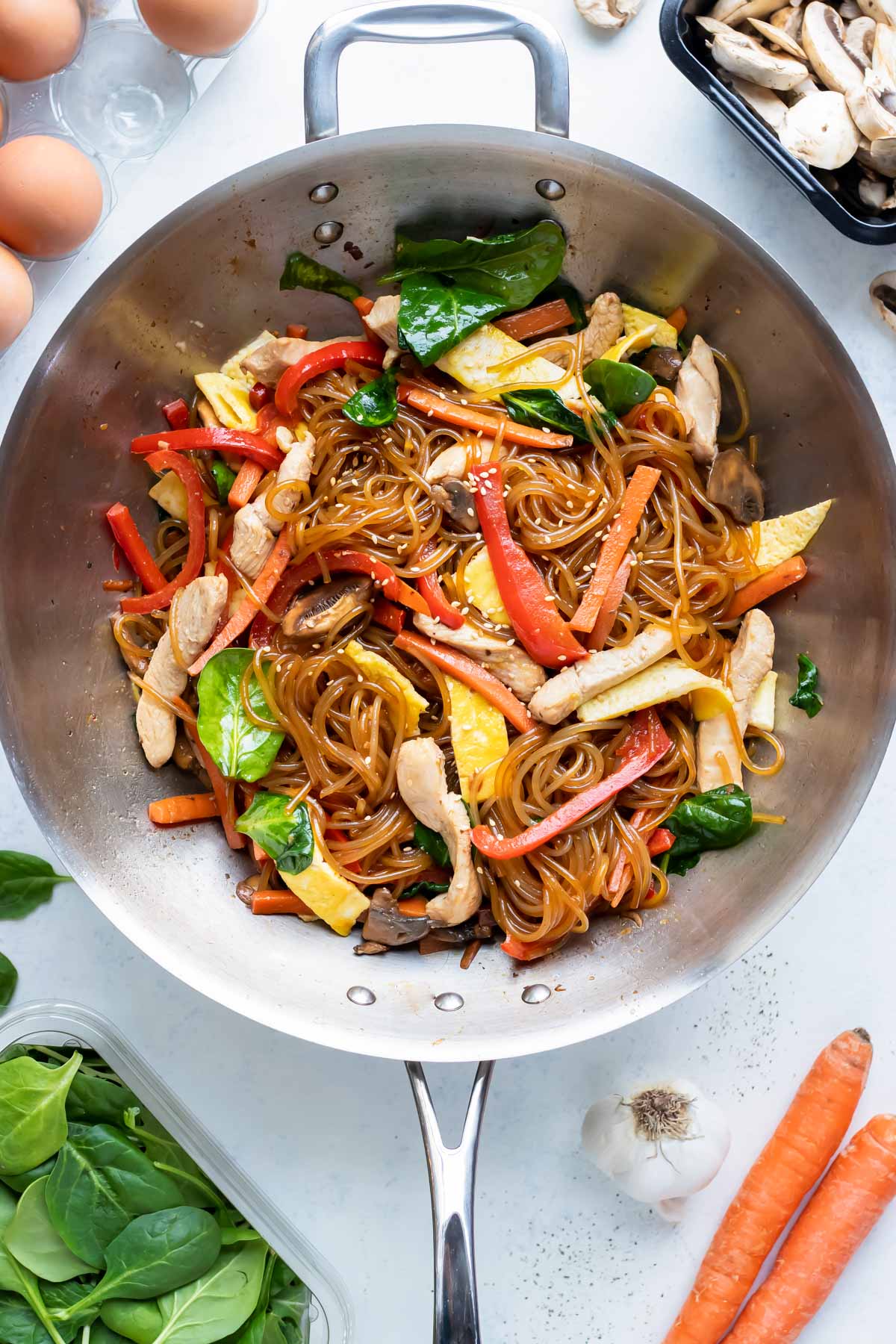
FAQs
Yes they are! This dish packs in a ton of nutrients since it boasts lots of veggies and lean protein. The glass noodles are similar in nutrition to other noodles, but are gluten-free.
Korean glass noodles, or dangmyeon, are made from sweet potato starch and water.
Japchae tastes savory, slightly sweet, and has the tiniest amount of heat. This recipe gets its flavor from soy sauce, sesame oil, and an array of veggies and seasonings.
Expert Tips and Tricks
- Keep it hot. By cooking at a high temperature, you’ll get the perfect crisp to everything without overcooking.
- Use the right oil. Avocado, safflower, peanut, and canola oil are all high smoke point oils that won’t burn when stir-frying.
- Let the ingredients marinate. The longer the noodles and chicken sit in the sauce, the more flavor they will absorb.
- Cook the eggs thin. This is the most authentic way to cook them, and it adds an amazing texture to the dish.
- Use what you have. This recipe can be made with lots of different ingredients – shiitake mushrooms, beef, green onions, and more!
Tap stars to rate!
Japchae – Korean Glass Noodles Recipe
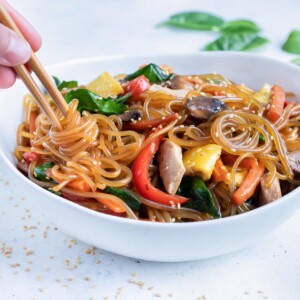
email this recipe!
Ingredients
Glass Noodles & Sauce:
- 8 oz. glass noodles
- ⅓ cup soy sauce gluten-free or Tamari
- 2 Tbsp. brown sugar or coconut sugar
- 1 ½ Tbsp. sesame oil toasted
- 2 cloves garlic crushed
- ½-1 tsp. sriracha sauce
- ½ tsp. salt to taste
Eggs:
- 1 Tbsp. avocado oil
- 3 eggs
- ¼ tsp. salt
- ⅛ tsp. black pepper
Stir-Fry:
- 2 Tbsp. avocado oil divided*
- 1 lb. chicken breasts thinly sliced
- 1 Tbsp. soy sauce
- 1 tsp. rice vinegar
- 1 clove garlic
- 2 carrots peeled and julienned
- 1 red bell pepper cut into ¼-inch slices
- 1 cup mushrooms sliced
- 2 cups spinach baby leaf
Instructions
- Combine chicken, 1 tablespoon of soy sauce, rice vinegar, and 1 clove of garlic in a large bowl. Toss until the chicken is well coated and let marinade for 20 minutes.
Glass Noodles:
- Bring a large pot of water to a boil. Once boiling, add glass noodles and cook for 6 minutes.
- While the noodles are cooking, whisk together the remaining sauce ingredients a medium sized bowl until well combined.
- Drain the noodles in a colander and then add back to the pot with the sauce. Toss until well combined and let sit for 20-30 minutes.
Eggs:
- Whisk eggs, salt, and pepper in a large bowl until combined.
- Place a large non-stick skillet over medium heat and drizzle oil over the entire bottom of it.
- Pour in whisked eggs and swirl the skillet around until the eggs cover the entire bottom.
- Cook for 2-3 minutes, or until the eggs are cooked through.
- Delicately remove the eggs from the skillet and place on a cutting board. Cut the egg circle in half and then cut it into thin strips about ½-¾ inch wide. Set aside until ready to use.
Stir-Fry:
- Place a wok or a large skillet over medium to medium-high heat and add 1 tablespoon of oil.
- Let heat up and then add the marinaded chicken. Stir fry for 3-4 minutes or until the chicken is cooked through. Remove the chicken from the skillet and set aside on a plate.
- In the same wok or skillet, add another tablespoon of oil along with the carrots. Stir-fry for 2 minutes, stirring occasionally, and then add in the bell pepper. Cook for another 2 minutes and then add in the mushrooms. Once the vegetables are almost cooked through but still crisp, add the spinach and cook for 1 minute or until it begins to wilt.
- Add the cooked chicken, noodles, and eggs to the skillet and cook over medium heat for 4-5 minutes, or until all ingredients are heated through.
- Serve Japchae with a sprinkle of toasted sesame seeds and enjoy!
Tap stars to rate!
Notes
- You can also use another high smoke point oil such as safflower oil, peanut oil, or canola oil.
Meal Prep and Storage
- To Prep-Ahead: This entire recipe can be made ahead of time because the flavors only get better! But if you just want to do a little prep beforehand to make dinnertime easier, you can cut up the veggies and chicken up to 1 day in advance. If you take this route, wait to cook the noodles until just before serving.
- To Store: Keep any leftovers in an airtight container in the refrigerator for up to 3-4 days. Freezing is not recommended as the textures will will change once thawed.
- To Reheat: For the best results, reheat by adding back into a skillet on medium heat for 5-8 minutes. But remember, this dish is also great cold!
Nutrition
Nutrition information is automatically calculated, so should only be used as an approximation.

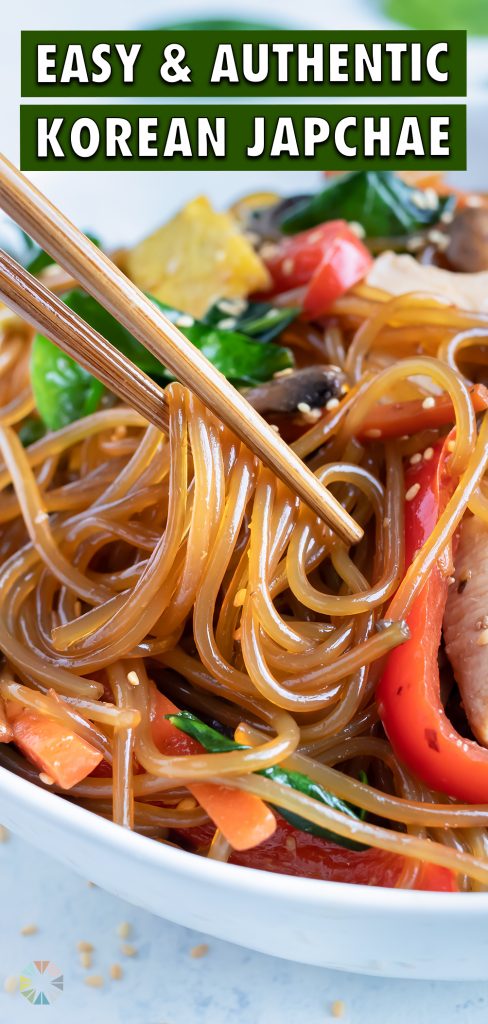
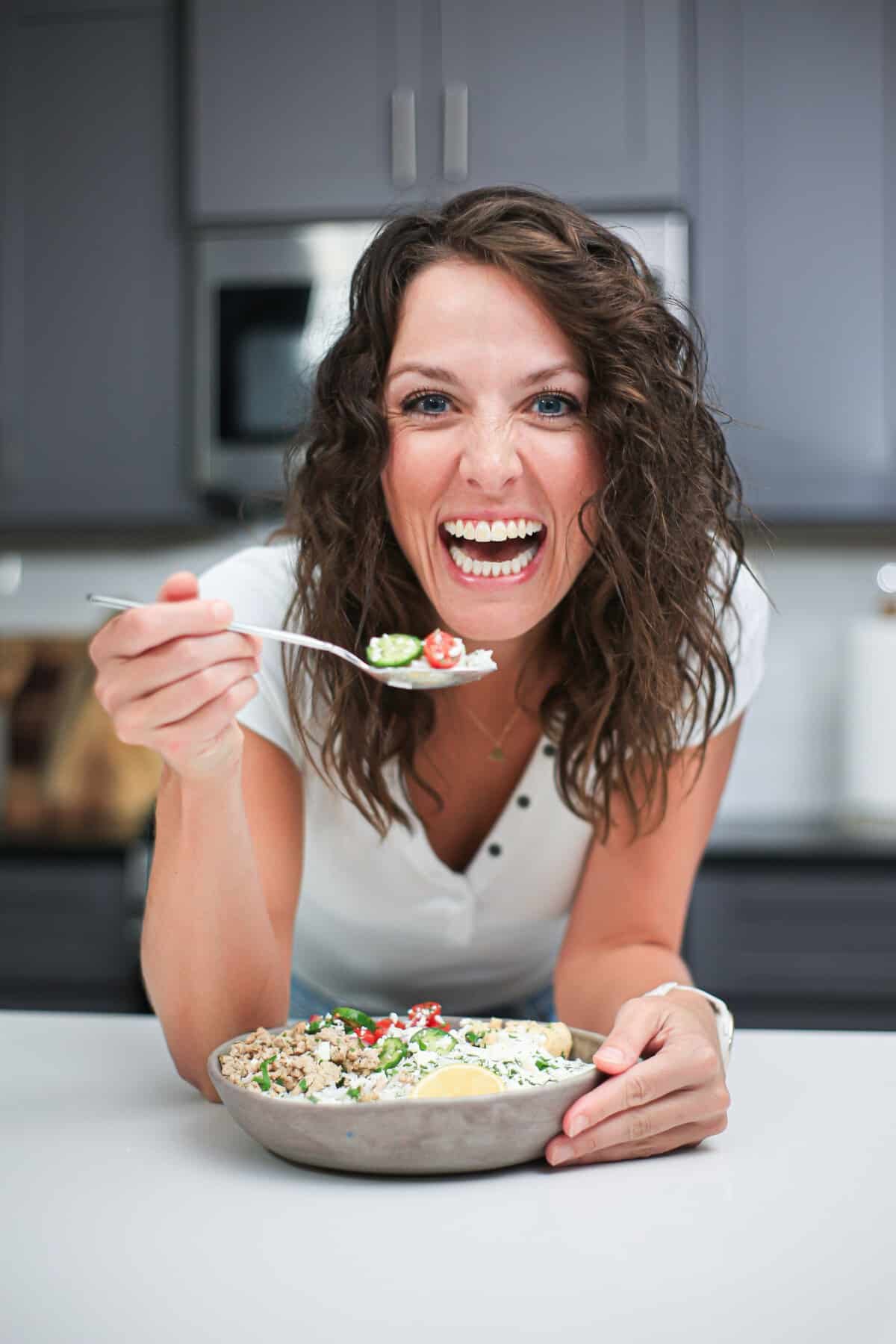
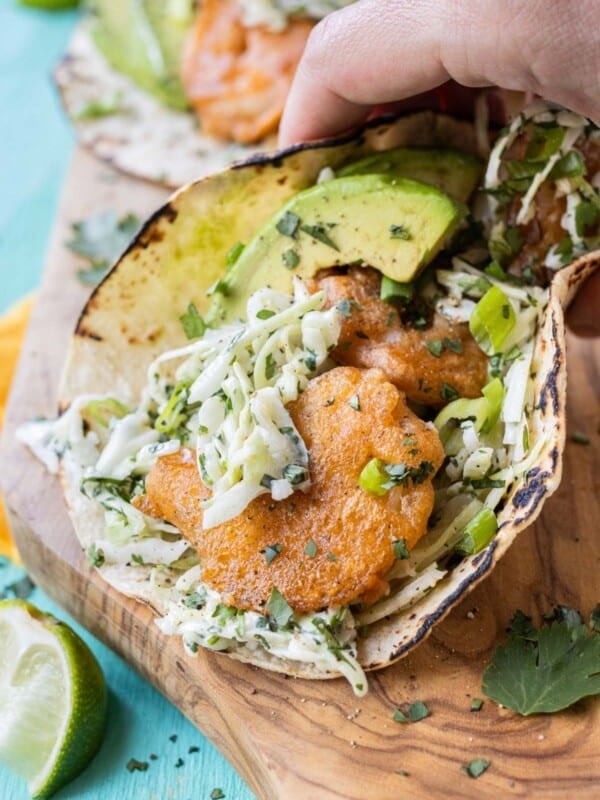
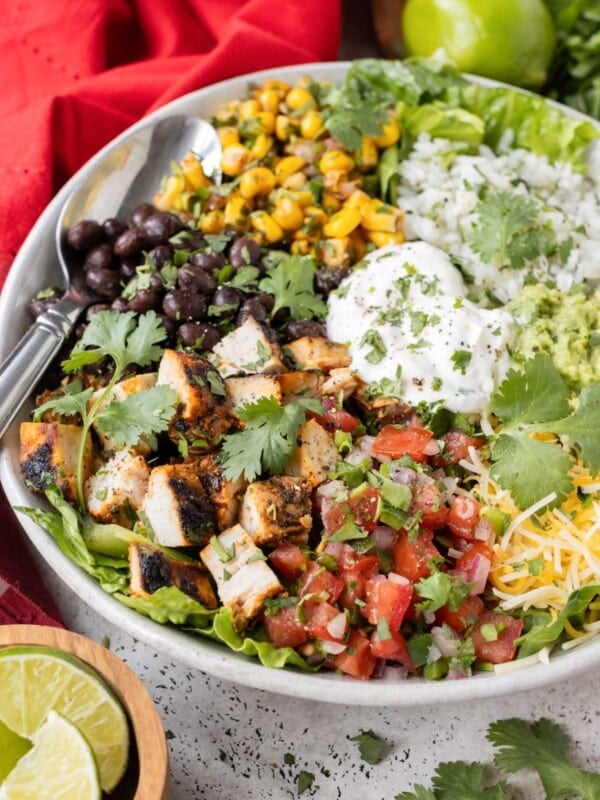
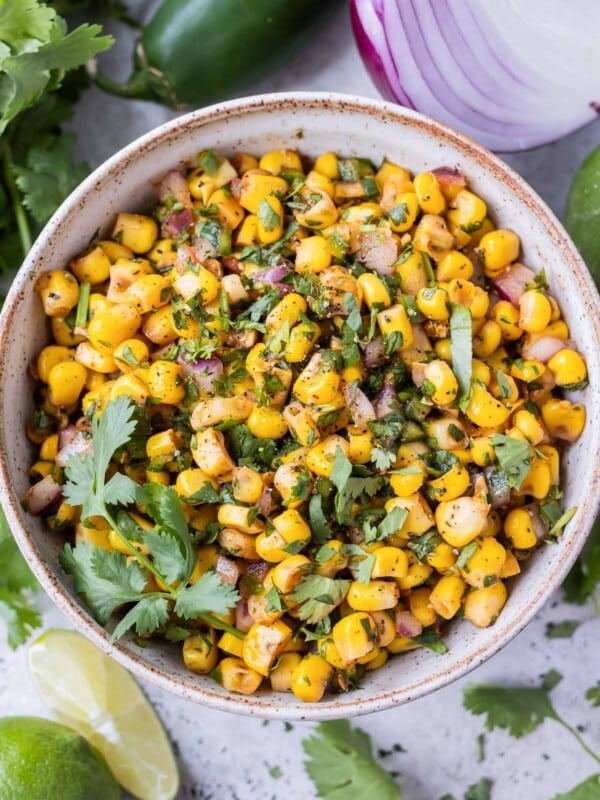
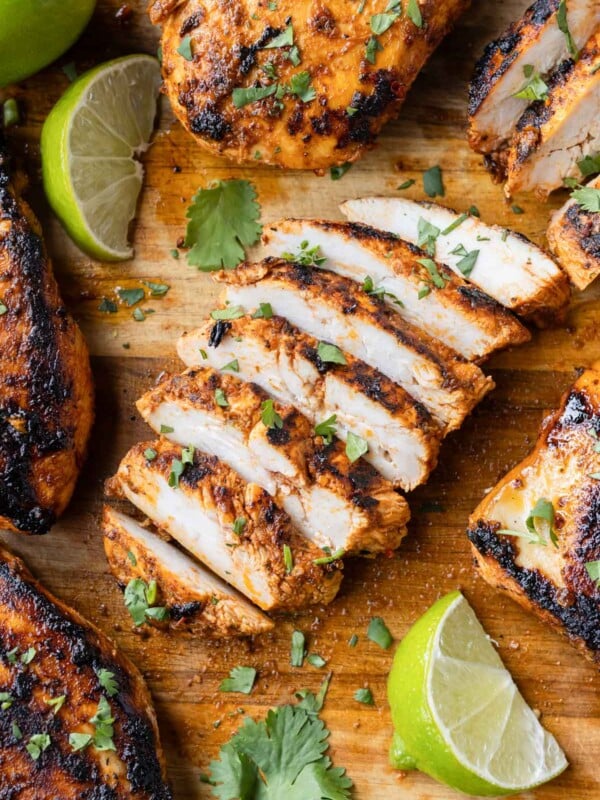









When you said whisk the eggs, you meant to keep them whole but whisking usually assumes they are out of the shell. How do you cook whisked eggs and then you cut the yolk? Please explain. Thank you.
This is a perfect weeknight or any night meal, just packed with delicious rich flavor!
Yay! So happy to hear you enjoyed the recipe, Wendy! I agree! Thanks so much for taking the time to leave a comment and rating!
Wow! This article is an authentic and exhausted guideline for everything about the Jabchae. I assume a Korean chef submitted the article. Thanks for the very useful information!
Yay! So happy to hear you enjoyed the recipe, Kee! I’m glad you found the instructions useful and authentic. Thanks so much for taking the time to leave a comment and rating!
absolutely loved it will be a regular for sure
Yay! So happy you enjoyed this recipe, Lesley! Thanks for commenting and leaving a rating.